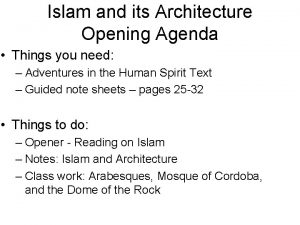ARCHITECTURE Introduction to Humanities The Humanities Through The






































- Slides: 38

ARCHITECTURE Introduction to Humanities The Humanities Through The Arts F. David Martin & Lee A. Jacobus


Buildings are works of art – that is architecture. Buildings possess artistic quality -- they make our living space more livable. They draw us to them rather than push us away or make us ignore them. They make our living space more livable. ARCHITECTURE

Centered space is the positioned interrelationships of things organized around some paramount thing as the place to which the other things seem to converge. Space is the material of the architect Centered space has a pulling power that, even in our most harassed moments, we can hardly help feeling. Centered Space

Architecture as opposed to mere engineering -- is the creative conservation of space. Architects perceive the centers of space in nature, and build to preserve these centers and make them more vital. Architects are the shepherds of space. Space and Architecture


Chartres, like most Gothic churches, is shaped roughly like a recumbent Latin cross: p 149 or 156 Fig 6 -2 & 6 -3 The apse ( a projecting semicircular and vaulted part of a building) or eastern end of the building contains the high altar. The nave (the central part of a church running lengthwise) is the central and largest aisle leading from the central portal to the high alter. But before the altar is reached, the transept crosses the nave. Both the northern and southern facades of the transept of chartres contain glorious rose windows. Chartres


Living space is the feeling of the positioning of things in the environment, the liberty of movement, and the appeal of paths as directives. Space infiltrates through all our senses, as our sensations of everything influence our perception of space. Living Space


Each of our senses helps record the positioning of things, expressed in such terms as “up-down, ” “left-right, ” and near -far. ” These recordings require a reference system with a center. With living space, since all the senses are involved, the whole body is a center. Living Space cont’d

when we relate to a place of special value, such as the home, , a “configurational center” is formed in a place that is a gathering point around which a field of interest is structured. To oversimplify we can say that for Romans, it was the city of Rome to which they most naturally belong, constituting their configurational center. Cont’d

The architect’s professional life is perhaps more difficult than that of any other artist. Architecture is a peculiarly public art because buildings generally have a social function, and many buildings require public funds. More than other artists, the architects must consider the public. Four Necessities of Architecture


Thus architects must be psychologists, sociologists, economists, businesspeople, politicians, and courtiers. They must also be engineers, for they must be able to constructurally stable buildings. Architects have to take into account four basic and closely interrelated necessities: technical requirements, use, spatial relationships, and content. Four Necessities of Architecture cont’d

Of the four necessities, the technical requirements of a building are the most obvious. Buildings must stand (and withstand). Architects must know the material and their potentialities, how to put the materials together, and how the materials will work on a particular site. So architects are engineers. But they are something more as well - artists. Four Necessities of Architecture cont’d

Functional Requirements of Architecture Architects must not only make their buildings stand but also usually stand them in such a way that they reveal their function or use. Some believe that (form must follow function). If form follows function in the sense that the form stands “for” the function; of its building, then conventional forms or structures are often sufficient. No one is likely to mistake Chartres Cathedral for an office building. Four Necessities of Architecture cont’d p. 153 / p. 162

Spatial Requirements of Architecture A building that is technically awry with poor lighting or awkward passageways or cramped rooms will distract from any artistic meaning, and so usually will a form that fails to reveal the function of its building, or a form that fails to fit into its spatial context. Four Necessities of Architecture cont’d p. 158 / p. 165

Revelatory Requirements of Architecture The function or use of a building is an essential part of the subject matter of that building, what the architect interprets or gives insight into by means of his form. Four Necessities of Architecture cont’d p. 158 -163 / p. 165 -169

Essential values of contemporary society are a part of all artists’ subject matter; part of what they must interpret in their work, and this-because of the public character of architecture--is especially so with architects. The way architects (and artists generally) are influenced by the values of their society has been given many explanations. Four Necessities of Architecture cont’d

To participate with a work of public architecture fully, we must have as complete an understanding as possible of its subject matter - - the function of the building and the relevant values of the society which subsidized the building. p. 162 / p 168

Works of architecture separate an inside space from an outside space. They make that inside space available for human functions. And in interpreting their subject matter (functions and their society’s values), architects make space “space. ”

They bring out the power and embrace of the positioned interrelationships of things. Architecture in this respect can be divided into four main types: 1) the earth-rooted, 2) the skyoriented, 3) the earth-resting, and 4. earth -dominating architecture.

The earth is the securing agency that grounds the place of our existence, our center. No other thing exposes its surface more pervasively and yet hides its depth dimension more completely. Architecture that is earth-rooted discloses the earth by drawing our attention to the site of the building or to its submission to gravity, or to its raw materials, or to its centrality in outer and inner space. Earth-Rooted Architecture (1)


Such architecture discloses a world by drawing our attention to the sky bounded by a horizon. It accomplishes this by means of making a building appear high and centered within the sky, defying gravity, and tightly integrating the light of outer with inner space. Sky-Oriented Architecture (2)


Most architecture accents neither earth nor sky but rests on the earth, using the earth like a platform with the sky as background. With earth-resting architecture - unlike earthrooted architecture--the earth does not appear as an organic part of the building. Rather, the earth appears as a stage. Earth-Resting Architecture (3)




An earth-dominating building does not sit on (like earth-resting) but “rules over” the earth. Earth-dominating buildings generally are easily identified. Usually earth-dominating buildings are large and massive, but those features do not necessarily express earth-dominance. Earth-Dominating Architecture (4)



No use of space has become more critical in our time than in the city. Therefore, the issues about space and architecture take on a special relevance with respect to city planning. Urban Planning


Most cities are planned either sporadically in segments or not at all. Some cities have height restrictions and in some cases top stories have been removed from buildings in construction. Some tall buildings create dark streets in the middle of the day. Is it possible to make the city a place to dwell? Urban Planning cont’d

 Humanities through the arts
Humanities through the arts Introduction to humanities ppt
Introduction to humanities ppt Through one man sin entered the world, and through one man
Through one man sin entered the world, and through one man Dome of furcation
Dome of furcation Through and through timber conversion
Through and through timber conversion Night of scorpion
Night of scorpion College of humanities and social sciences
College of humanities and social sciences Historical development of humanities
Historical development of humanities Discovering the humanities 4th edition
Discovering the humanities 4th edition What is medical humanities
What is medical humanities Where was the early renaissance (ca. 1400-1490) centered?
Where was the early renaissance (ca. 1400-1490) centered? Landmarks in humanities 4th edition
Landmarks in humanities 4th edition Landmarks in humanities 5th edition chapter 1
Landmarks in humanities 5th edition chapter 1 Humanities 101 art appreciation
Humanities 101 art appreciation Ldap cuni
Ldap cuni Columbus humanities arts and technology academy
Columbus humanities arts and technology academy Art and humanities endorsement
Art and humanities endorsement Composed primarily to be sung.
Composed primarily to be sung. Local guide program
Local guide program What is humanities
What is humanities What is humanities
What is humanities Essay about humanities
Essay about humanities Ca humanities
Ca humanities Ihsst
Ihsst Humanities art appreciation ppt
Humanities art appreciation ppt Functions of art
Functions of art Digital humanities
Digital humanities Arts and humanities endorsement
Arts and humanities endorsement Spread of islam through architecture exit slip
Spread of islam through architecture exit slip Architecture business life cycle
Architecture business life cycle Call and return architecture in software engineering
Call and return architecture in software engineering Examples of integral product architecture
Examples of integral product architecture What is product architecture
What is product architecture 3 bus architecture
3 bus architecture Hình ảnh bộ gõ cơ thể búng tay
Hình ảnh bộ gõ cơ thể búng tay Lp html
Lp html Bổ thể
Bổ thể Tỉ lệ cơ thể trẻ em
Tỉ lệ cơ thể trẻ em Gấu đi như thế nào
Gấu đi như thế nào



























































